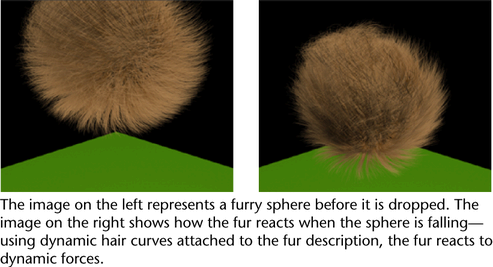If you are animating your scenes, you can create more natural looking fur by making it react to movement and forces. For example, when an animal shakes its fur, the fur does not typically stay in one place (unless it is very short)—it reacts to the movement of the body. Similarly, long fur blows around on a windy day.
To style fur and create realistic dynamic fur simulations, you use hair curves, which are connected to the Fur description. These curves can be of any length or shape. They can be either static (for styling) or dynamic. Use dynamic hair curves when you want to make fur react to dynamic forces. For example, you can set up the fur on a dog so that when it shakes itself, the fur reacts appropriately.

To modify the look of Fur, use the Fur Description attributes; to edit the dynamic behavior of the Fur, use the attributes in the attached hairSystem node.
The basic workflow for adding movement to fur is as follows
Threshold Length (0.33) * Global Scale (10) = 3.33
Length of the fur description = 1.5 < 3.3 so the fur is not influenced by curve attractors.
 Except where otherwise noted, this work is licensed under a Creative Commons Attribution-NonCommercial-ShareAlike 3.0 Unported License
Except where otherwise noted, this work is licensed under a Creative Commons Attribution-NonCommercial-ShareAlike 3.0 Unported License